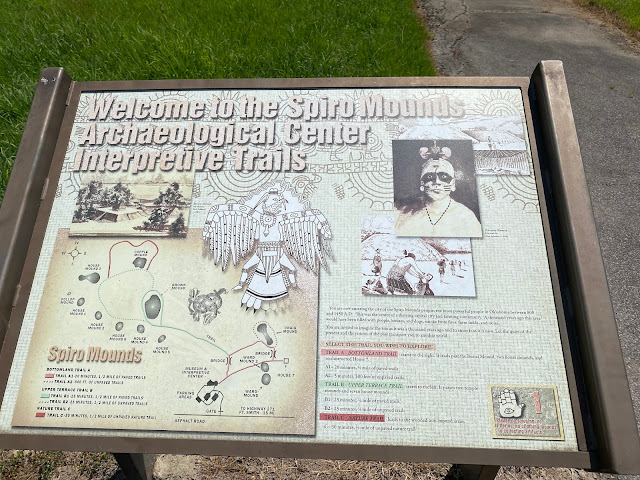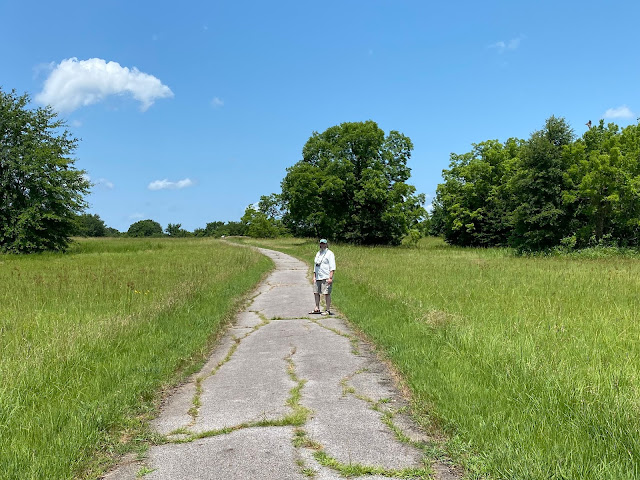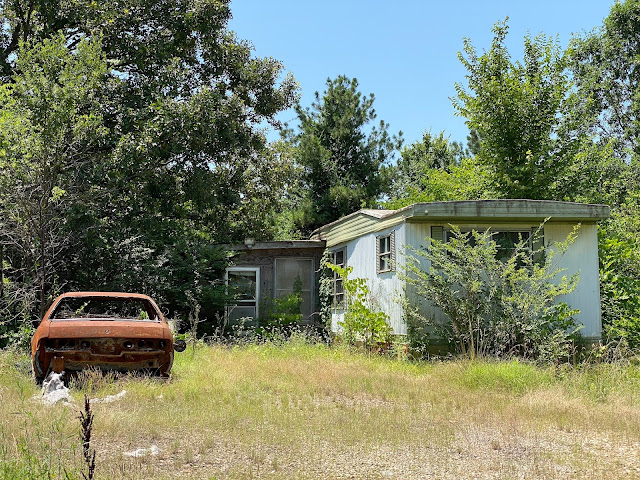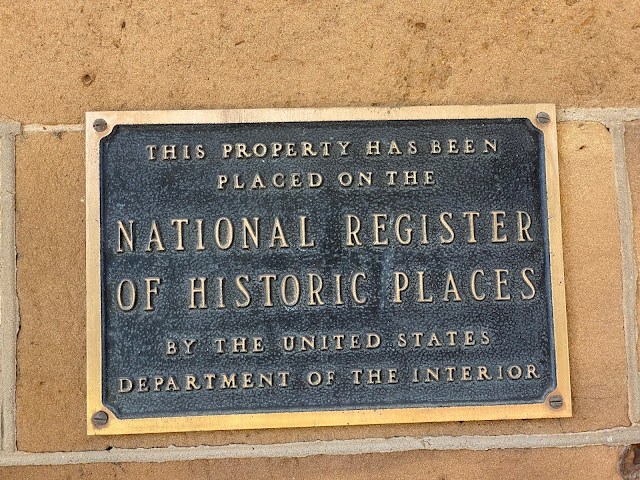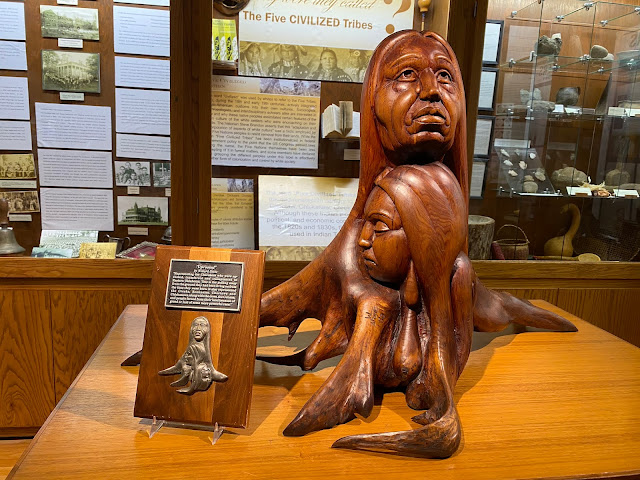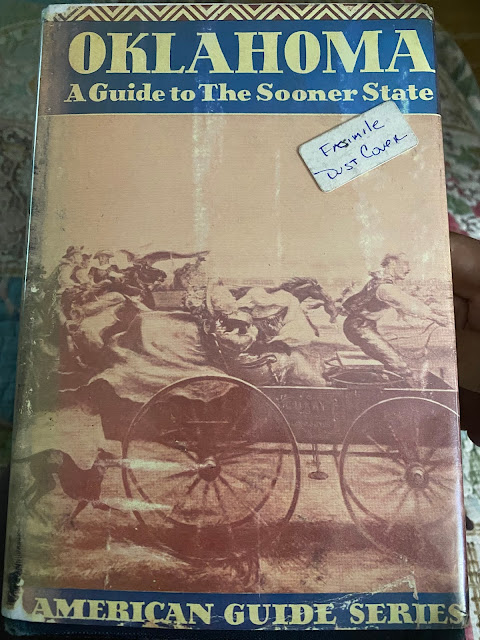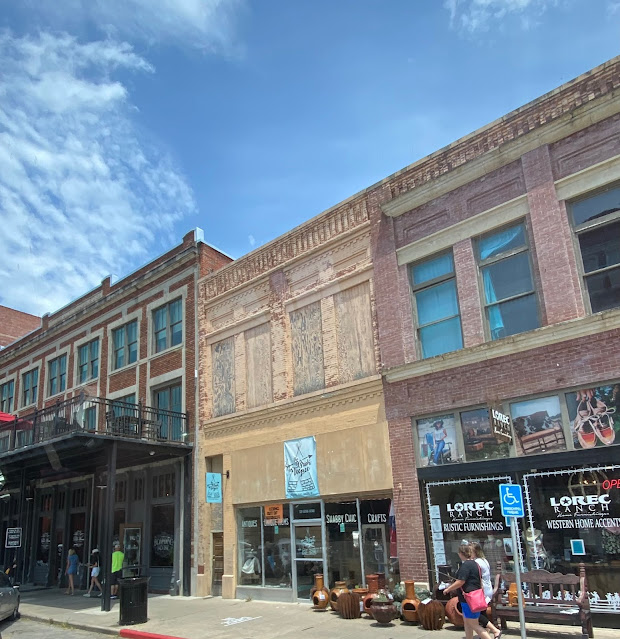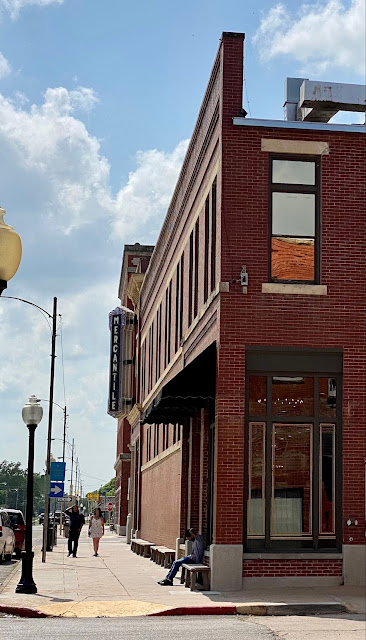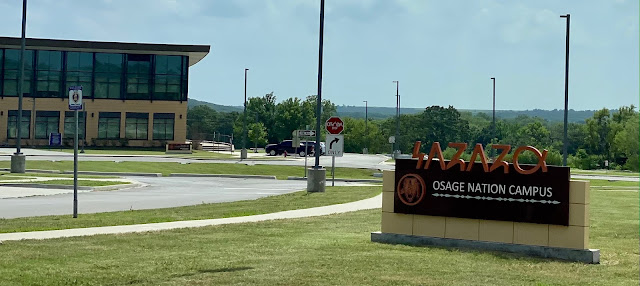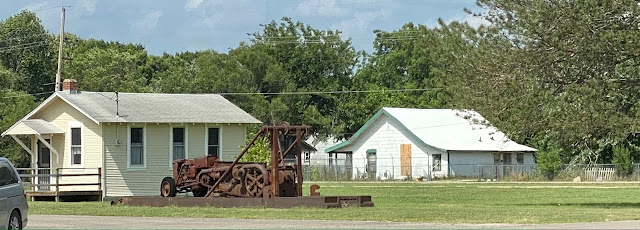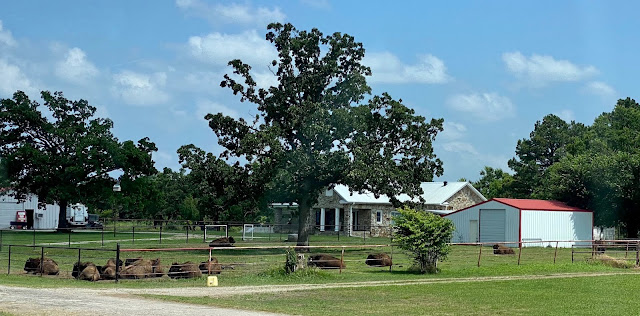Now isn't that a big statement, "Indian Territory"? Who came up with this term? Invaders? Immigrants? Interlopers? And what exactly is this territory that is referred to by the Federal Government, Settlers, Cowboys (and I'm sure a few cowgirls too)? I bet if you asked a Native American, they would say this whole country is their tribal lands, and that would be speaking truth to power. I wish it was as simple as that. But it is not.
Another situation in the good 'ole USA, similar to slavery, in that the situation and the territory as defined by white folk, were imposed upon a group of people against their will. And also that a whole lot of what happened to this group of expelled people before, during, and after their "relocations" were abominable acts. Acts scarcely talked about in the hallowed halls of public schools- a great deal of it "hidden history."
Today, the region’s First Peoples, primarily the Osage, Quapaw and Caddo nations, endure as federally recognized tribal nations in Oklahoma, where they continue to rebuild after centuries of systemic injustice. In acknowledging this, and as I traveled about the region seeing, touching, feeling, and absorbing all I can of these aboriginal as well as dispossessed lands and landowners, I offer a sincere apology for the systemic injustices that have been visited upon these peoples and the land. It is theirs and I am only but a visitor. I tried my best to be a good visitor, and a humble witness to all the pain and misery that my interloper relatives and government has visited upon them.
Have I mentioned that I hate Andrew Jackson? Not loathe, which I had vowed to use in all other circumstances since hate was such a strong emotion. Until I learned about this vile president and the Indian Removal Act of 1830. Learning that, btw, did not happen in K-12 school or college.
Ignorance is bliss until you get "woke." Once woke, that aching in the heart begins. And lasts. So I gobbled up books, and trolled the internet for information. Have been educating myself for over 30 years now.
Years ago I became interested in "Indian Territory" when doing some background research on a Unit of Study on the Indigenous Peoples in the U.S. I was really curious on 2 things: 1. How many Indigenous People still existed in the U.S.?, and 2. Where did they live?
That's around the time I learned of the "Trail of Tears," and the terminus of this trail in a newly minted (and a pretty shitty agricultural land to boot) territory that at the time was not even a state. The "pushed aside" people. Ah Manifest Destiny!
So I tend to circle back to things that make my heart ache b/c I can not sustain involvement for long; with little ability to understand the f@#*ed up treaties that were made and broken, made and broken, or not knowing who, where, and how I could go to apologize and pledge to personally do better in the future.
Helpless, helpless, helpless.
The 1970's brought all those "Billy Jack" movies that bled my heart. That was my young education on the uneasy coexistence that "we" Americans had with the wronged Native folk out west. Hell, we were still teaching about the wonderful pilgrims and Indians in Massachusetts and the harvest of plenty that produced "Thanksgiving." Except, whenever I looked around I saw no Native Folk. I had not even heard of Cape Cod Mashpees or MA Wampanoags or the struggles of the Indigenous folk of Mass for Federal recognition.
I read and read and read. More recently I reread about another horrible series of events that happened in Northern Oklahoma approximately 100 years ago. "That's it," I said. If I am going to bear witness and seek truth to power on the Tulsa Massacre, then I must also travel North and send out a karmic apology and pledge in Osage County. In actuality, I was traveling across 4 Prairie states, and I could be spewing apology all over the place, but I was meaning to be intentional and go specifically to the scene of the crime so to speak to do my spewing. Another book I read, "Unworthy Republic" (full title= Unworthy Republic: The Dispossession of Native Americans and the Road to Indian Territory) by Claudio Saunt is a "damning synthesis of the federal betrayals, mass deportations, and exterminatory violence that defined the 1830s." It really set the stage for me to go seek out the spaces that Native Americans were pushed to.
Off we went. Starting off in Southeastern Oklahoma at an ancient site, we tried to capture as much of the surrounding area from there and throughout our travels to see who is still here, where is here, has integration taken place, and how do the white people feel about and/or treat the Indigenous people in their midst?
A place that means many things to many people. The territory can and has been a subject of heated debate for a very long time. The word "Oklahoma" means land of the Red People in the language of the Choctaw.Who came first? How was + is it divided now? How come this tribe can put a sign here and not there? It was readily clear that we were in "Indian Territory" even if we did not know exactly what that meant.
This was the view of Fort Coffee, Ok that we first came upon. Not sure if many would question why such a small place (less than 400 pop) would have this sort of name, but I did. "Fort" is the giveaway. Built as a fort in 1834 and named after a man who had battled the Seminoles in the South. To me this was a pretty yukky name for a town especially knowing that there is evidence of prehistoric roots that are most definitely Indigenous peoples. Also, the fort came about b/c of removal/expulsion of Choctaw Nation peoples from their ancestral lands to this area at that 1834 time. Depending on whose history you read, there is conflicting information about this settler history (the Choctaw asked for this fort to be built for example).
To complicate matters, many of the Indigenous people from the Eastern coast on down through the South had acculturated to the immigrant's capitalistic ways and came to this territory with black slaves. This new learning was really hard for me as a black person to learn.
What does this yard ornamentation mean? Is it decorative? Interpretive? Or both? Nary a soul to be seen in this tiny rural place, so I really couldn't ask anyone, even though I really really wanted to know. After the Civil War the Choctaw were ordered to release their slaves, so I wonder if any of them stayed in this area? Did the Choctaw and Black folks get along? Have a common enemy?
The main drag of the town is a country byway, Route 271. Old, dated signs point the way to the Spiro Mounds.
And a little further along was this picture. I really wondered how this interpretive picture of prehistoric or ancient ones was derived. Who were these people? When were they here? I was excited to learn it all.
Then we came to this! What a major bummer. We saw our only humans at this point. they were heading back from their hike. It was the hottest day of the trip, somewhere in the mid-90's, but we decided to go for it. Well some of it- the park sits on 150 acres.
What looked like a child's sandbox out in one field we guessed was likely a real or simulated archaeological dig.
Watch and try to imagine a once thriving village/town of a nation of ancestral people.
Some of the mounds were hard to see.
And some readily observable. However, as with most ancient places around the world, looting, marring, and downright destroying of sites has happened over the years. Most of the mounds as well as artifacts (in the CLOSED center) are reproductions.
It was interesting to learn of their houses. Construction is oddly similar to many of the homes that we saw along our journeys. They are midwestern prairie-like things. Is it form following function? Ancient architectural questions.
Double hump's of dirt covered in grass. Boring to some, fascinating to others. These were the Natives and this IS their ancestral lands. We are the interlopers. I try hard not to forget this.
We said goodbye to, well... no one. It was a serene, quiet place. I wondered if spiritual forces remain and if ceremonial events happen here.
Everything in the town had the old, worn look- even the signs.
On the right side of this picture was a curiosity that my husband pointed up.
We forgot that we are in what old-timers used to call "Tornado Alley." These tornado shelters range from simple on up and average cost of one is between $2,500-7,500.
MUSKOGEE
Next stop was to find out about another strange term, "Five Civilized Tribes". I know for damned sure that no Indigenous person gave their Nation or Tribe such a ridiculous name. Maybe some bought into it (as their was actually a museum with the name) after it was used, much in the same way that some folks went from being Colored to Negro to Black to African American. Self-determination it is not, more acculturation, assimilation, and who is controlling the collective consciousness of the cultural norm for different times, places, and spaces.
Mostly I wanted to know, if there were "civilized tribes," then where and what were the uncivilized ones? I never did find out. Mostly b/c the woman at the desk of the Five Civilized Tribes Museum was so nice I didn't want to create uncomfortableness.
I know the Federal Government created this term. Here is a bit from the National Archives on the subject:
"The Dawes Act of February 8, 1887 marks a turning point in determining tribal citizenship. This Act developed a Federal commission tasked with creating Final Rolls for the Five Civilized Tribes of Oklahoma (Cherokees, Chickasaws, Choctaws, Creeks, and Seminoles). The Commission prepared new citizenship rolls for each tribe, incorporating names of approved applicants while simultaneously documenting those who were considered doubtful and ultimately rejected."
Sometimes I get so mad at the world, USA, and the internet. Searching for this place was one of those times. Okay, truth-telling here= yes I am a lazy interneter at times + do a quick check of Wikipedia (I sure hope none of my former students are reading this). Something is terribly wrong when the first paragraph of the history of this place is "French fur traders were believed to have established a temporary village near the future Muskogee in 1806, but the first permanent European-American settlement was established in 1817 on the south bank of the Verdigris River, north of present-day Muskogee."
So we know there were vast numbers of ancestral people in this territory, there have been archaeological studies done that verify that. I also know that somehow Muscogee is related to modern day Creek Indian, and yet there is Wiki talking about French and Europeans. I call Bullshit! This term Five Civilized Tribes was meant to refer to the people who had "adopted" Anglo-European ways and got along with the white colonizers and settlers.
Here is a bit of historical info on the basis of this place name:
Muscogean – A language family containing Alabama, Apalachee, Calusa, Chickasaw, Choctaw, Coushatta, Creek, Hitchiti, Seminole, and Yamasee tribes. Originally they were confined chiefly to the Gulf states east of almost all of Mississippi and Alabama, and parts of Tennessee, Georgia, Florida, and South Carolina. According to a tradition held in common by most of their tribes, they had reached their historic seats from some starting point west of the Mississippi, usually placed, somewhere on the upper Red River. Later, most were moved to Indian Territory.
https://www.legendsofamerica.com/tribe-summary-l-m/#Muskogean
My understanding is that now the Creek folk call themselves the Muscogee Nation. Creek was a British given name, while Muscogee was/is their native name.
Some other interesting historical factoids about the Muscogee (Creek):
- Descend from woodland people of Georgia and Alabama.
- Built a colony in Ocmulgee GA + spread out from there.
- Creeks derived their identity from their clan, but also from the town where they lived.
- There were at least 50 Creek towns in the early eighteenth century, with a combined population of more than 20,000.
- Not all Muscogee agreed with the assimilation/acculturation efforts of the white settlers. Some of them fought the US Forces, and after losing= forced to cede over 20 million acres in GA + AL. Sadness supreme, IMHO.
- Resistance to US Gov't and REMOVAL/EXPULSION continued by some up until 1836.
- Around 13,000 Muscogee made it to Indian Territory.
"This old stone building..." What the hell is that supposed to mean? And "consolidated offices"? Does all that sign says mean "this old clunker is what we are giving you folks so shut up and make the best of it," because that is how I interpreted it as saying.
The building, completed in 1875, was first used as the home and offices for the Superintendent of the Five Civilized Tribes. The building has been used for many other things, one of which I found hard to reconcile in my mind. It was once the home and school for Creek Freedman. I really struggle with this notion and have never meet anyone who can say, "my people were once owned by Creek Indians." The hurt just goes round and round and round.
The building is on the National Register of Hx'ic places (see the plaque?) and has gone through many changes. It fell into disrepair after WWII, was given to the city, then the Feds, and finally back to Indigenous folk, who made it the museum.
Each artifact in the yard has some sort of significance. This bench was originally intended to be used in the Washington Monument.
The Federal Government erected the VA Center that shares this site in 1923. On Nov. 30, 2006, it was renamed the Jack C. Montgomery VA Medical Center, making it the first VA medical center named for a Native American.
Inside, although in a small space, there were many artifacts and a lot of historical reading to do. Plus air conditioning! This beautiful wood sculpture is titled, "Uprooted."
This fascinating section/exhibit is all on boarding schools. I could have spent all day just reading every single word in this exhibit (if I were alone). Alas, I skimmed.
We spent what seemed like hours and hours trying to find the remains of this school. Out in the rural countryside near Okmulgee, it was a school run by the Presbyterian Church. We did not find it :(
Little did we know that when we crossed the bridge we were then in Bristow, Ok. Bristow was once a trading post on Creek land in Indian Territory (all pre-statehood, such confusing history out here). As you may have guessed, after the railroads started coming thru at the turn of the 20th century, then came the white men and before too long white settlers called the place home, and the town was "founded" in 1901 and named after a white man + the 4th Asst. Postmaster General.
We thought this home looked like a school of some sort, but it is not. It is a private residence built in 1963.
Tuskeegee Church Bristow, Ok The name Tuskegee comes from a Creek Town in Alabama and is from the word 'taskialgi' which means "warrior". How it got attached to this abandoned church is lost to me. There is also a Tuskegee Indian Baptist Church, but I am not sure if they are the same.
After what seemed to be at least 3 or 4 loops of this very rural area, and as dusk encroached upon us we spotted this marker. We were thrilled to pieces.
...because this is what we got for the crazy drive around we did. Disappointment supreme!
As we dejectedly left the area, we came upon some more abandoned property, and this one gave us a laugh.
If you zoom in, you can barely make out the name, "Haydonville Assembly of God." The name is very similar to the small town we hail from in MA. This place, which is/was a small unincorporated space, began about 1916 with the clearing of this once "wild" land by a man, Grover Haydon. He came looking to build a Pecan empire.
By 1834, our forefathers were forced to walk to the Indian Territory (Oklahoma) on what is known today as the Trail of Tears from our ancestral tribal lands in the southeastern United States. However, our Mvskoke leaders ensured that our traditional legacy was continued and protected here.
The sacred fires are built with logs pointing to the east, west, north and south; the four cardinal directions. This is the basis of many traditional Mvskoke concepts. The earliest Mvskoke teachings instruct that our sacred fires are to burn eternally. If extinguished, the Mvskoke will perish.
During the rituals, dances and prayers, the smoke rises from the sacred fires and it fades into the skies. The smoke carries the messages of the Mvskoke people to the Creator. These ceremonies are not primarily for personal benefit, but rather the benefit of the entire community or nation.
Fire is a revered element of many sacred rituals of the Mvskoke (Muscogee Creek People). The sacred fire represents the divine masculine of the “Epofvnkv” (the Creator) to which all things are connected.
It was a very quiet in this lovely neighborhood that seemed to be up higher, with the Arkansas River nearby and a shit-ton of swanky houses all around. This Burr oak tree was where the 1st town hall, court of law, and church were and it is still a revered site.This is the Will Rogers High School. It was built in 1939 using Works Progress Administration workers (Yeah! I love the WPA and all their projects to get folks back to work after the Great Depression).
This school has been called one of the best examples of Art Deco school architecture in the country.
This is one of the two tower-like entrances that flank the front of the building. The slightly more decorative tower has a white panel directly above the doors and then two octagonal medallions featuring Will Rogers, one in a cowboy scene and the other with a movie camera, plane and rodeo rider. “Will Rogers High School” is inscribed in gold below these medallions.
There is a large amount of ornamentation on the outside of the building and of course, a Nat'l Register Plaque to boot.
It was ornamental, pristine, and the wood- OMG!
The Bas Relief terra cotta panels were out-of-this-world!
This panel has 3 stanzas from John Greenleaf Whittier's poem "The Kansas Emigrants." I was astounded to read. JGW is from Massachusetts and a distant relative of his was my next street over neighbor. It sure is a small world out there!
The lights remind me of those that are in some of Frank Lloyd Wright's houses.
- stage and film actor
- vaudeville performer
- cowboy
- humorist
- newspaper columnist
- social commentator
Not much to see in this town. At first we thought this was a car dealership, but at 2nd glance= a company that has something to do with oil (of course). Extract Production Services is the company name.
Aha! We made it. This county in Northeastern Oklahoma is the largest area in the state. Although large in area, the total population for the county is less than 50,000. Current demographics has the White population as approx. 66%, Native folk at 14%, and Black at 11%. About 7% are identified as mixed race. It is named after the federally recognized Osage Nation, a midwestern Great Plains people from around 700 BC who were expelled pushed off tribal lands and then relocated from Kansas by a treaty with the Feds (Feds thought they were moving the tribe to worthless, rocky + untillable land). The treaty made in the 19th century established the Osage Reservation.
The term "Osage" is a French version of the tribe's name which roughly translates as "calm waters." From wiki:
Next up was a cute little town named Barnsdall. It has a population of about 1,200 and we made it through town in less than 5 minutes.
The most notable person from the town is Anita Bryant (who later moved to Tulsa and went to Will Rogers High School). Allegedly she had some Top 40 hits in the 50's + 60's but most people of my generation know her as the asshole lady from orange juice commercials who was an anti-gay activist. Ms. Bryant comes up again in our travels in another state.

I'm sure there is a story behind this place. In fact it used to be quite the showpiece as it had a collection of signs, gas station pumps, and assorted other visuals. Jack died and everything except the Indian went away.
This block used to be the Bank of Bigheart. It is a National Registry of Historic Place. All the way out in OK it was pretty cool to see an almost Richardsonian Romanesque building (another example of native rock use in buildings, sandstone this time). The bank changed names, then locations in 1976 and as you can likely guess, it has gone through several different businesses. Despite the religious icons, I am not even sure if the building is in use at the moment.
You think they maybe could have put a memorial to James Bigheart in this downtown Barnsdall Park!? No..... Who knows what the heck is going on here.
Sadly enough, besides Anita Bryant, this little spot is what puts Barnsdall on the map. It even made my favorite "Atlas Obscura."
After seeing the small one in Barnsdall, we started seeing more and more of these oil wells,
and more and more of the derricks. It was a visual reminder of the complex relationship that developed in Indian Territory before statehood in Oklahoma.
Petroleum development in the Osage Reservation, which is part of the vast Mid-Continent oil and gas region, proceeded slowly in the late 1890s. Inadequate transportation, declining prices for oil, and other problems caused further delays. Only after the turn of the twentieth century were producing wells brought in. Beginning with a successful first well near Bartlesville, only forty wells had been completed by 1903. In 1904 a pipeline was constructed to the Standard Oil Refinery in Neodosho, Kansas, reducing transportation costs by nearly 40 percent. The next year over three hundred wells were brought into production. In 1907 the Osage oil fields produced more than five million barrels.
Over the next two decades the Osages' "underground reservation" would produce more wealth than had all of the American gold rushes combined.
History from: https://www.okhistory.org/publications/enc/entry.php?entry=OS006
Enter into the time period known up in these parts (and more recently around the US due to publicity and books written about the events that followed) as
THE REIGN OF TERROR
Ingest this information:
Unlike other landholders, the Osage were able to retain collective ownership of subsurface mineral rights, rather than having to accept allotments to individual owners. Instead, tribal members received "headrights" that assured them an equal share of mineral rights sales equivalent to income from 658 acres. A headright could not be sold, but an individual could sell his or her surface rights. An average Osage family of a husband, wife, and three children would receive more than $65,000 a year in 1926, and by 1939 Osage individuals had received a total of more than $100 million in royalties and bonuses.
And hold as we move on down the road...
In case you forget about the place and times- these markers were all over the Prairie states we visited. Bank robbers, outlaw gangs, vigilante justice- all that stuff of tv images of the midwest in the "wild, wild, west" times played out in the 20th century. This was mind-blowing to me. Yet, very little of what happened in the "Reign of Terror" made it out or into history books, or on markers.Some places, like all over the Prairie, looked like time had stopped mid-century.
Hominy Oklahoma is another small town outside the regional center of Pawhuska. Not much to see in this place. Another territory that came about as the Osage moved into the territory (or alternatively some whites will claim homesteading in the late 1800's, which in my mind is justification of the ever-present and ongoing encroachment on tribal lands by whites especially back in the day). The name of the town is from a tribal leader Ho'n-Mo'n-I'n/Walks in the Night. Hominy, like some other small towns around the area was a town that was exempted from the Osage Allotment. Instead the land was surveyed, plotted, and lots were auctioned off in 1906. This is where the homesteading of whites (and blacks in some areas) came into play. At one time Hominy had an all-Indian professional football team (1925), but now the historic marker for the town goes to the progenitor of the Drummond Empire, a white man named Fred, and the house they built "as a reflection of financial success." We did not stop or drive by this house, although unbeknownst to us, we were to learn much more about the Drummond family further on down the road.
Further down the road we came into Pawhuska. This is the county seat and a to give you an idea of what it is like up here in Northeastern Ok, the town's population is approximately 3,500. I also think that some folks call this town a city. It seemed to us to be pretty sparse as we came into town.
- US 60 traverses the confines of the old Osage Nation, now Osage County. Indian teepees once dotted the rocky hills but today they have been replaced by "stripper wells" and "pumping jacks."
- In 1872, the Osage Indians were removed from Kansas to Silver Lake, and then to this tract of almost 1,500,000 acres...
- Their new lands were composed of hills and prairies, which was much to their liking, for they were naturally hunters and fighters rather than farmers.
- ...Others adopted the white man's way and became ranchers themselves.
- During the period of luxury for the Osages, it was not unusual to see a blanketed Indian-braids down his back and a stetson on his head- at the wheel of an expensive automobile...
- Chief Bacon Rind's (I kid you not- it is in this book on page 289, whose Native name was Wah-she-dah or "Star-That-Travels") home...has been allowed to deteriorate since his death ...one of the best-liked Indians. After his death...the funeral was a strange mixture of traditional Christian and Indian burial rites; weirdly singing mourners were employed...
- The town, which still has the traditional Indian atmosphere...
It belongs to this product- Sinclair gas. Here's what they have to say about themselves:
"The Sinclair dinosaur is one of the most popular icons in American petroliana."
Back In Time: Osage Murders - Reign of Terror
Our view and my feeling= just another Christian church, so what. But obviously this church was/is a big deal to many in the community. This church became an intersection point (besides intermarrying/mixed bloods which also happened) and also a National Historic place with it's own Wiki page https://en.wikipedia.org/wiki/Immaculate_Conception_Church_(Pawhuska,_Oklahoma
And you can see that there was a GREAT push on to get the Indians acculturated to the "white man's ways" in Oklahoma.
Not quite like in the boom years, there are many tired-looking spots and some blight on the ends, but in the middle is some bustle from the Pioneering Woman tv fame and spin-off product sales at "The Mercantile,"and of course the movie making. Pawhuska has had other movies filmed in the town + area, but this is a big time movie with big name people AND it is about what happened to Indigenous folks at the hands of White folk.
It was hard to figure out what the tall building on the hill was from this vantage point (we found out later on the tour). Also, quite a few abandoned properties even if the town was teeming with folks.
What was going on under those mysterious tents??? Production place for the film crews.
As we drove through the downtown of Pawhuska, the tour guide spent more time on the filming side of going ons vs. the history of the place (a bummer for us). It was hard to keep up with what was really there vs.fake-made for the movie.
This notorious building was there, has some history, but nowadays it is a boutique hotel. Here is a "THEN" photo:
The Deaths of Sybil Bolton and
Bloodland: A Family Story of Oil, Greed and Murder on the Osage Reservation
Lurking in the background is the town courthouse. It was here that the nefarious acts of the white citizenry were exposed and several were held accountable (with untold numbers escaping justice- so many injustices all around here, it makes me sad).
The courthouse was built in 1914 and is a quite impressive structure.
Is it real or is it fake. Very hard to tell. The main thrust of the tragic story did not actually take place here in Pawhuska, but in the nearby much smaller town of Fairfax. Unfortunately, this already diminished and somewhat blighted town was struck by a tornado in 2018, destroying many of the storefronts, so they were being recreated here in Pawhuska.
From a different angle you could see that these were not actual places. It was sort of freaky.
Notice the window lettering?
Notice the window lettering?
All over town this was the scene. Will have to go back and reread the books I read to match the names to the places. It was amazing how industries and businesses were started by white men to price gouge and take advantage of the Osage money that came during their golden era from the oil boom. I can't even imagine what it was like. In that way movies are magical for recreating what once was. Later, when we visited the original places from the books, it was a stark reminder how much time and history had ravaged them.
This building was once iconic to Fairfax, Ok. Built in 1913, it was torn down in 2020. It was the biggest business in Fairfax, and the owner at the time of the Reign of terror was complicite in the awful deeds going on. In fact, the company was sued in 1925 for the inflated cost of a deceased person's funeral.There was word that a memorial to the murdered Osage may be put in up in the empty space.
Homer Huffaker
One of the pioneer white men in the Osage country, identified with the thriving Town of Fairfax since its beginning, now the head of one of the largest mercantile concerns there, and also one of the present county commissioners of Osage County, Homer Huffaker is one of the men who have made their influence count for improvement and development in this section of the state.
He belongs to one of the oldest and most prominent pioneer families of the State of Kansas.
...He became an assistant at Gray Horse in the Osago Nation to L. A. Wismeyer in the trading store, and remained in that locality until 1903, when he joined in the business exodus from Gray Horse to the new railroad town founded by Mr. Wismeyer and named Fairfax. For two years Mr. Huffaker was assistant cashier in the Osage Bank of Fairfax. When the Wismeyer Mercantile Company was formed and incorporated he became its secretary and treasurer, and was identified with the concern in that capacity for ten years. In 1913 he organized the Big Hill Trading Company of Fairfax, and is now its president. This firm carries a large stock of general merchandise, and has extensive trade relations both with the white and Indian population around Fairfax. In many ways Mr. Huffaker has been identified with the business and civic upbuilding of Fairfax since it was founded. In 1907 he added to the improvement of the town by the erection of the fine home in winch he and his family now reside. He has also acquired farming and stock raising interests in that locality.
In politics he has been a republican voter for twenty years. In 1912 he was elected county commissioner of Osage county, served as chairman of the board during his first term, and was re-elected in 1914. He was also chairman of the first delegation which chose a representative for Congress from the Osage country, and assisted in nominating former Congressman Bird S. McGuire. Mr. Huffaker is a thirty-second degree Scottish Rite Mason, belongs to the Nobles of the Mystic Shrine, and is also a member of the Elks Lodge of Pawhuska.
This is also a fake scene. It is a fabricated railroad station, made and situated by the Bird Creek in Pawhuska, even though it was Fairfax that had the station.
In the southwestern section of the reservation were a few small towns that were Indian villages. A white man convinced the RR to have a depot in the town that he basically was running, even though the Osage retained title to to the townsite acreage. The RR bypassed Gray Horse and built in Fairfax instead. After that Fairfax grew steadily, while Gray Horse remained a small village/town. Today both places are small, with Fairfax having lost almost half its population (pop. approx. 1,400).
More made up storefronts in downtown Pawhuska.
Yeah right! Nothing old inside this store, unless you are counting me.
In a strange twist to my constant search for integration of races and cultures, there was the awkward moment when I went upstairs to get an iced coffee and saw "back-of-the-establishment" workers with brown skin, whereas there were none on the 1st floor in the merchandise/clerk area. Just observing...
In the pictures below, there was another odd occurrence. I had specifically wanted to drop into this unique little store that I read about, "Sister's Attic."
It is a consignment shop that doesn't look like much from the outside.
Look what was advertised out front. I thought for sure I would get to meet and talk to Osage folk in this integrated store.
Even this one gave me pause.
By the time I got to this one I was downright dismayed. No mention anywhere about the use of Indigenous actors in the movie. No word from the Osage on how it felt to have Hollywood around here dredging up the awful history visited upon the Native people. When we got to the counter, there were two blonde white woman, one of which callously mentioned to her coworker that she had no idea on how to pronounce the name of the Osage woman she needed to call in response to my inquiry on a consignment piece. They bantered around a couple of pronunciations will I impatiently waited. I was so bummed out. Where is the coexistence? It really did seem like a tale of two cities, and I was only getting to hear/learn about one side.
In the end, we found a magnet for our travels collection that was done by a fellow from the Muscogee Nation,
It was fascinating to see things like reserved parking signs written in both English and the Osage language.
Superintendent's Home has been residence to 30 Osage Agency Superintendent's and is listed on the national Register of Historical places.
Osage Nation Human Resources Office
The Million Dollar Inn is what the sign says. It is a property across the street from the Osage Agency complex. This is an Osage owned and operated business. Our tour guide did point out a few of these things. What stayed with me was the pejorative term she first used in describing the homes that Osage folks built. "Red Mansions" was how she disdainfully labeled the first one that she pointed out. These homes are sprinkled all over the territory and they were distinguished by the use of local brick (hence the double-entendre meaning of "red"). However, not all the homes were brick.
To the right in this photo is Chief Claremore statue done by Osage Sculptor John Free. Osage Nation Tells its Story
I was so jealous to see these two actually visiting. Although the tour guide slowed the van for a minute or two, she never stopped and never asked if we wanted to get off to look at anything.

The Osage Nation Museum is the oldest tribally-owned and operated museum in the United States. The Museum opened its doors in 1938. Heartbroken that we did not get to visit.
Another statue, this one done 2 years before Chief Claremore. This one is "Chief James Bigheart, renown among the Osage for his wise leadership. from Chief Bigheart is known for his leadership in negotiating the 1906 Osage Allotment Act that preserved and provided ownership of the Osage Mineral Estate, leading to great wealth among the Osage. He is credited with holding up the signing of the act for 10 years until the mineral rights were preserved.
Many different homes along Grandview Ave. It definitely was "the" place to be. Perhaps still is. Not sure how much is Osage-owned nowadays. The 2010 census showed only 14% Native American and 66% White.
This was one of the "Red Mansions" pointed out to us. Osage-owned.

This ranch sits almost directly across the street from the Drummond Ranch, which kind of sums up the relations around here (kind of like in your own neighborhoods. You know- the neighbor you are nothing like, but you each tolerate the other but don't hang together or anything):
I was so curious about this place. It sort of looked like a multi-unit apartment or some such building.
A back street, one-off from Main St. (W. Fifth St.) near Bird Creek. The latest in fashion= a glamping pod. There are only 3. They are $80/night and have
- ADA Accessible
- Air Conditioning
- Electricity
- Heat
- Water Hook-Up
The Dam Place a general store and campground that is operated by Help Works, a non-profit organization. Sounds pretty good...except that this was their neighbor.
And oddly enough, the general store for the pods is located on Main St. A very strange set-up indeed.
The Joseph H. Williams Tallgrass Prairie Preserve at 39,650 acres is the largest protected piece of tallgrass prairie left on earth. Urban sprawl and conversion to cropland have left this once expansive landscape, originally spanning across 14 states from Texas to Minnesota, at less than 4% of its original size.
Since 1989, The Nature Conservancy in Oklahoma has worked to restore this fully functioning portion of the tallgrass prairie ecosystem with the use of 2,500 free-ranging bison and a "patch-burn" model approach to prescribed burning.
In case you were wondering, no Joe Williams is not an Osage. He is former Williams Co. CEO, chairman of both the Oklahoma Board of Trustees and the National Board of Governors for The Nature Conservancy, and lifelong hunter, fisherman and conservationist. At first the Osage were not for this project, not sure why.Yeah for Nature Conservancy!
We drove all the way up there and stared at the grass. It was odd and awkward.

Not sure if this is part of the Osage Ranch or not.
Even found film crew signs along the highway. Damn movie people were following us and taking over entire parks (Osage Hills State Park w/ CCC buildings I so wanted to see) + shutting off public spaces. So glad they had already filmed in Fairfax and Gray Horse!











